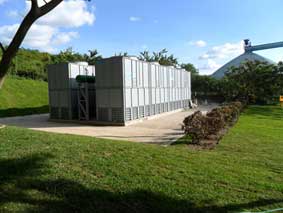Evaporative Cooling Towers
What are evaporative cooling towers
Evaporative cooling towers are heat dissipation systems that exploit the
principle of evaporation to cool a mass of water through an exchange of air with the
environment.
Forced evaporation removes heat from the water, causing it to cool.
This process has been known since antiquity, when it was applied through the use of
terracotta amphorae, which kept water cool by allowing very small amounts of water to ooze
out due to the porosity of the material.
What are evaporation cooling towers used for
To date, evaporative cooling towers are mainly used in industrial contexts, to disperse the
heat produced by machinery, and are essential in all processes where a thermal cycle is
present, in other words where there is a need to cool the water and then put it back into the
circuit.
Evaporative cooling towers, with a few simple measures, manage to cool
the water to below ambient temperature, because they exploit the principle of latent
exchange of evaporation.
Latent exchange of evaporation, unlike other systems that remain bound to the
room temperature as the attainable cooling limit.
How evaporative tower cooling systems are made
Evaporative cooling towers can be classified into natural draught towers and mechanical
draught towers.
Natural draught towers exploit the density difference between air and water vapor to
circulate air and therefore do not require fans.
Mechanical draught towers, on the other hand, are the most commonly used type of
evaporative cooling tower, and normally consist of: a containment structure perforated at the
base to allow air circulation through a fan, a system that distributes the water inside, and a
tank where it is collected once it has cooled and then recirculated.
How the evaporative cooling towers works
There are open-circuit and closed-circuit evaporative cooling towers.
To make the most of the latent heat exchange principle, open-circuit evaporative cooling
towers have a high contact surface area between air and water.
In this type of circuit, the tower receives a large quantity of water at high temperature, which
is distributed in the containment structure.
Through the heat exchanger (where heat exchange takes place between
water and air against the current), a small part of the water evaporates while the remainder
cools down.
The evaporative cooling towers can then be fed back into the industrial process. In towers
closed-circuit cooling towers, on the other hand, the process water does not come into direct
contact with the air, but remains inside a heat exchanger, and is therefore always free of
polluting components.
How the maintenance of these systems is carried out
Obviously, these processes dissipate water, because a small amount of it must necessarily
evaporate during the cooling cycle.
The salts contained in the water, however, remain dissolved in the remaining water,
increasing its concentration.
For this reason, it is essential to periodically check their levels.
In addition to this, anti-limescale treatments and partial purging should be carried out.
Industrial and civil applications of evaporative cooling towers
While natural draught towers are used in geothermal energy and in the construction of
nuclear power plants, mechanical draught towers are widespread in all industrial plants
where a constant cooling system is required due to the presence of delicate equipment.
However, they are also used in the civil sector, for example to keep water cold during the
summer season.
Due to their easiness of use and minimal maintenance requirements, evaporative cooling
towers
are the best solution for cooling industrial plants.
With the exception of the fan, they have no special mechanical components moving
constant motion, and consequently also allow considerable savings in electrical energy.


















